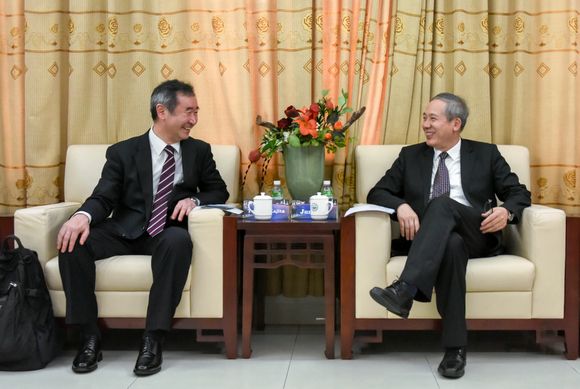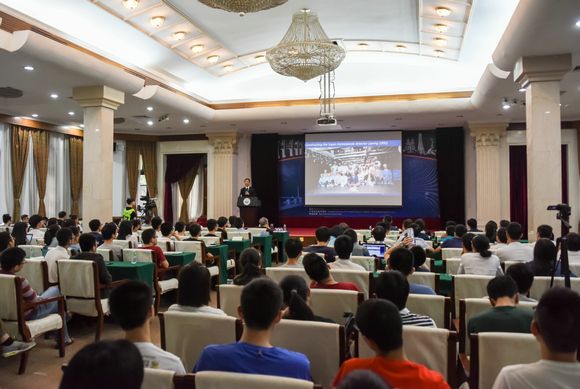Professor Takaaki Kajita, 2015 Nobel Laureate in Physics, gives a lecture at Sun Yat-sen University
Source: School of Physics
Written by: School of Physics
Photo by: Xiao Yao, Liu Jia
Edited by: Wang Dongmei
On the afternoon of April 7, 2017, the 15th Session of Nobel Laureates Series Lectures at Sun Yat-sen University (SYSU), organized by the State Administration of Foreign Experts Affairs, the Administration of Foreign Experts Affairs of Guangdong Province, and Sun Yat-sen University, was held in Swasey Hall on Guangzhou South Campus. Prof. Takaaki Kajita, the 2015 Nobel Laureate in Physics, the director of the Institute for Cosmic Ray Research at University of Tokyo, gave a lecture entitled “From Neutrinos to Gravitational Waves”. The lecture was hosted by Prof. Wang Wei. The State Administration of Foreign Experts Affairs sent a congratulatory telegram, which was read by Mr. Li Diyun, Director of Experts Office at the Administration of Foreign Experts Affairs of Guangdong Province. About 300 faculty and students from Sun Yat-sen University attended the lecture.

President Luo Jun meeting with Professor Takaaki Kajita
Before the lecture, Prof. Luo Jun, President of Sun Yat-sen University, met with Prof. Takaaki Kajita, and introduced the development of the University. Mr. Li Diyun, Director of Experts Office at the Administration of Foreign Experts Affairs of Guangdong Province, Ms. Gu Wenli, Deputy Director of Office of International Exchange and Cooperation at SYSU, Prof. Yao Daoxin, Deputy Dean of School of Physics at SYSU, and Prof. Wang Wei from the School of Physics at SYSU, also attended the meeting.

Professor Takaaki Kajita giving a lecture entitled “From Neutrinos to Gravitational Waves” at SYSU
During the lecture, Prof. Kajita introduced the physics knowledge for the "Kamiokande" Observatory, which was designed to search for proton decay. Although the original goal was not realized, the solar neutrinos can be detected by the detector. For the at that time well-known solar neutrino problem, following Observatory “Super-Kamiokande” was designed and built. In 1998, the Super-Kamiokande detected strong evidence of neutrino oscillation that successfully explained the solar neutrino problem. In other words, Super-Kamiokande proved that the flavor of neutrinos can be changed in the flight. This result showed that the neutrinos have mass. This is the first time in the whole human history, that the new physics beyond the Standard Model was found. Neutrinos are not massless as the Standard Model predicted. After the introduction of his work for Super-Kamiokande, Prof. Kajita made an outlook for neutrino physics. He pointed out especially, the Jiangmen Underground Neutrino Observatory (JUNO), which SYSU participates, will become one of the most important observatory for neutrino physics all over the world.
After research of neutrino physics for more than 20 years, Prof. Kajita decided to throw himself into the research of gravitational wave. During the lecture, Prof. Kajita made an introduction about the physics behind the gravitational wave and introduced the most leading-edge international projects for the research of gravitational wave. Especially, Prof. Kajita introduced the KAGRA experiment, which was led by Japanese institute and universities. KAGRA has two arms, which form a laser interferometric gravitational wave detector. It is built in the Kamioka Observatory (Kamiokande) near the neutrino physics experiments and need the cryogenic technologies. Prof. Kajita indicated that, there is not a project of the gravitational wave studies group currently, which can detect the global gravitational waves. In other words, the projects of the gravitational wave studies, as well as projects for other physics studies, more and more depend on international cooperation.
In the Q&A session, President Luo Jun, as well as the faculty and students present at the lecture asked questions, and Prof. Kajita's answers won many applauses.
Prof. Takaaki Kajita has shared the Nobel Prize in Physics in 2015 with the Canadian Physicist Arthur B. McDonald for the discovery of the neutrino oscillations, which shows that neutrinos have mass. This discovery changed our understanding of the innermost workings of matter and can prove crucial to our view of the universe.
The “Nobel Laureates Series Lectures” at SYSU is a high-level forum series supported by the project “Dialogue with the Master--Nobel Prize Winner’s Lecture Tour on Chinese Campus” and organized by the State Administration of Foreign Experts Affairs. It has become an education event with large influence in China and abroad. Since the Series Lectures started, 15 lectures were held successfully. More than ten Nobel Laureates in the field of chemistry, physics, medicine and physiology, and economics were invited to visit SYSU and give a lecture at SYSU.
